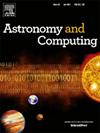Emulators for stellar profiles in binary population modeling
IF 1.9
4区 物理与天体物理
Q2 ASTRONOMY & ASTROPHYSICS
引用次数: 0
Abstract
Knowledge about the internal physical structure of stars is crucial to understanding their evolution. The novel binary population synthesis code POSYDON includes a module for interpolating the stellar and binary properties of any system at the end of binary MESA evolution based on a pre-computed set of models. In this work, we present a new emulation method for predicting stellar profiles, i.e., the internal stellar structure along the radial axis, using machine learning techniques. We use principal component analysis for dimensionality reduction and fully-connected feed-forward neural networks for making predictions. We find accuracy to be comparable to that of nearest neighbor approximation, with a strong advantage in terms of memory and storage efficiency. By providing a versatile framework for modeling stellar internal structure, the emulation method presented here will enable faster simulations of higher physical fidelity, offering a foundation for a wide range of large-scale population studies of stellar and binary evolution.
双星人口模型中恒星轮廓的仿真器
了解恒星的内部物理结构对理解它们的演化至关重要。新的双星族合成代码POSYDON包含一个模块,用于在二元MESA演化结束时,根据预先计算的一组模型插值任何系统的恒星和双星属性。在这项工作中,我们提出了一种新的模拟方法,用于预测恒星轮廓,即沿径向轴的恒星内部结构,使用机器学习技术。我们使用主成分分析进行降维,使用全连接前馈神经网络进行预测。我们发现精度与最近邻近似相当,在内存和存储效率方面具有很强的优势。通过为恒星内部结构建模提供一个通用的框架,本文提出的仿真方法将能够更快地模拟更高的物理保真度,为恒星和双星演化的大范围大规模种群研究提供基础。
本文章由计算机程序翻译,如有差异,请以英文原文为准。
求助全文
约1分钟内获得全文
求助全文
来源期刊

Astronomy and Computing
ASTRONOMY & ASTROPHYSICSCOMPUTER SCIENCE,-COMPUTER SCIENCE, INTERDISCIPLINARY APPLICATIONS
CiteScore
4.10
自引率
8.00%
发文量
67
期刊介绍:
Astronomy and Computing is a peer-reviewed journal that focuses on the broad area between astronomy, computer science and information technology. The journal aims to publish the work of scientists and (software) engineers in all aspects of astronomical computing, including the collection, analysis, reduction, visualisation, preservation and dissemination of data, and the development of astronomical software and simulations. The journal covers applications for academic computer science techniques to astronomy, as well as novel applications of information technologies within astronomy.
 求助内容:
求助内容: 应助结果提醒方式:
应助结果提醒方式:


